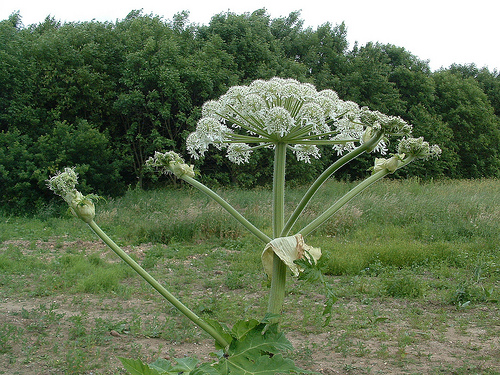By Sasha Moedt (The Cascade) – Email
Print Edition: May 23, 2012
The appearance of a dangerously toxic weed has become increasingly common across the Fraser Valley and Vancouver area. BC Ministry of Agriculture cites Heracleum mantegazzianum, giant hogweed, as a threat to both human health and the ecosystem.
The large, hairy plant that can grow up to six meters tall was introduced from Caucasus region and Central Asia as a “garden curiosity.” The plant is characterized by its thick, hollow, reddish-purple stem, small white flowers that form a broad umbrella head, and compound leaves that are deeply incised.
Giant hogweed is poisonous enough to cause great concern in BC. WorkSafe BC says the sap, found in the stalk, stem, and leaves can cause severe blisters and burns. These injuries do not appear immediately; the sap causes something called phytophotodermatitis, a chemical reaction that causes the skin to become hypersensitive to sunlight. Burn-like lesions appear after 24 hours, followed by blisters in 48 hours. These blisters can cause severe scarring, purple or black in colour. Worst yet, even a small amount of sap in the eyes can cause permanent or temporary blindness.
There is no foolproof antidote, but WorkSafe BC suggests immediately washing exposed skin with soap and water thoroughly, and to avoid sunlight one to two weeks after exposure to prevent blistering.
Hogweed is especially dangerous to those who aren’t aware of the physical dangers of the sap: children, campers and gardeners who take a weed whacker to them, spreading the sap everywhere. Children have been known to use the hollow stems as telescopes or peashooters, according to WorkSafe BC.
It is suggested to have professionals remove the plant if you find them in your backyard. For those choosing to do it on their own, WorkSafe BC recommends wearing protective, water-resistant clothing, covering exposed skin completely, and ensuring full facial protection before proceeding. It is also important to wash all clothing and tools following contact with the plant. The proper way to remove the plants is to manually cut the roots, or alternately, to cut near the base at a diagonal angle. Pulling out a whole root causes a soil disturbance that creates ideal conditions for seeds in the soil to germinate. As well, those removing the weed are warned against composting or putting the plants in a greenwaste bin. Instead, they should place the unwanted plants directly in the garbage – this prevents the seeds from dispersing. Hogweed is tenacious, and new growth may appear even after removal.
The main concern about hogweed is the physical danger they pose to people. But hogweed, BC Agriculture notes, is also a detriment to nature. The huge plant grows aggressively, with a tolerance to a wide variety of environmental conditions, making hogweed highly competitive with native species. The shallow root system can also cause soil erosion on steep slopes or river banks. Hogweed is commonly found near roadsides, creeks, vacant lots, ditches and any environment considered moist to wet.




